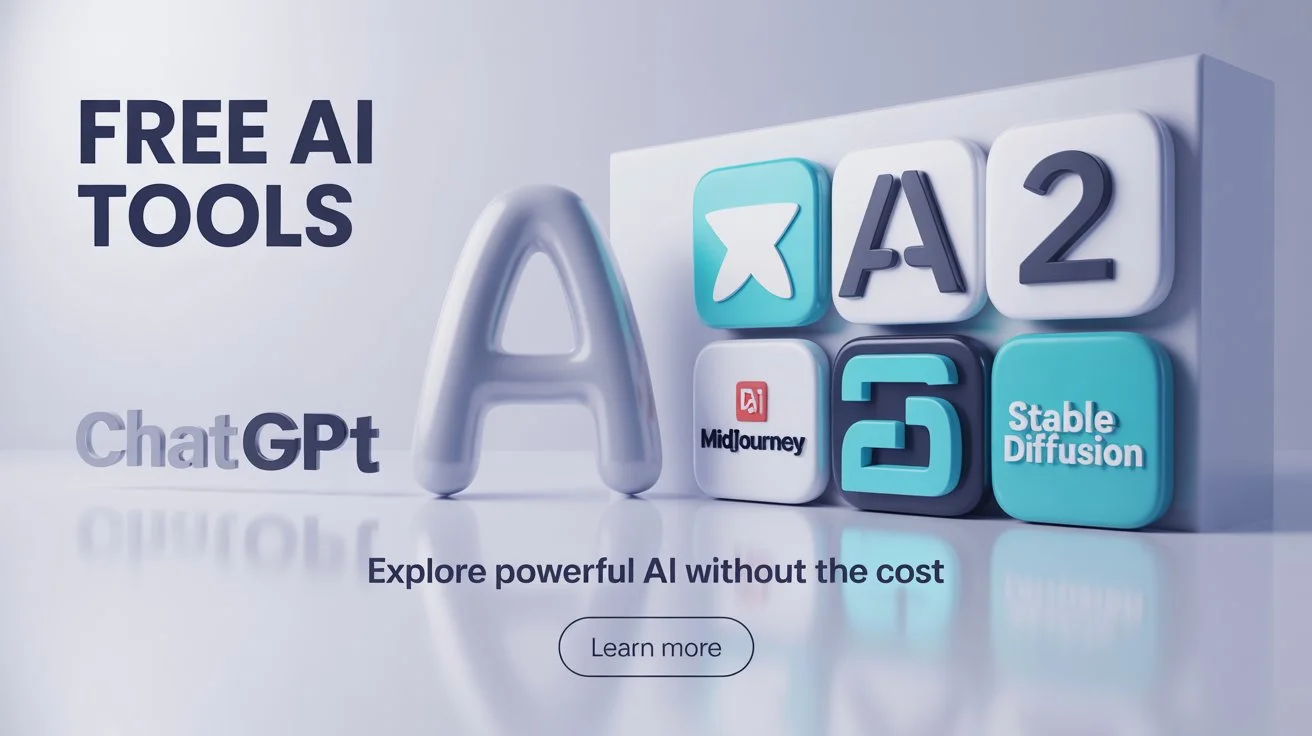Introduction
Imagine having a powerful digital assistant at your fingertips—one that can generate stunning images, draft blog posts, analyze data, or even translate languages instantly. Welcome to the world of free AI applications, where groundbreaking technology meets zero cost. Whether you’re a blogger, marketer, developer, or simply an AI enthusiast, this guide will walk you through the most accessible AI tools that won’t break your budget.
Table of Contents
In this post, we’ll compare leading free AI application, share unique insights from hands-on experiences, and reveal practical tips for integrating them into your workflow. Let’s dive in!
Why Free AI applications Are More Than Just a Gimmick
The rise of free AI applications tiers isn’t charity; it’s a strategic shift. Companies realize that lowering the barrier to entry builds massive user bases, fosters innovation, and trains their models on diverse data. For us? It means unprecedented access:
- Democratized Power: Top-tier AI capabilities once reserved for elite labs are now in your browser tab. An indie filmmaker can generate storyboards, a non-native speaker can polish emails, a student can grasp complex physics – all with free tools.
- Zero-Risk Experimentation: Want to explore AI art? Test a coding assistant? Build a chatbot? No credit card required. This freedom fuels creativity and skill-building without financial pressure.
- The “Try Before You Buy” Advantage: Many free tiers act as gateways to premium features, letting you thoroughly evaluate a tool’s value before investing.
Your Toolkit: Must-Try Free AI Applications (Across Key Categories)
Let’s move beyond hype and get practical. Here’s a curated look at powerful free AI applications delivering real value right now, complete with insights from hands-on use:
1. Writing & Content Creation Superchargers
- Claude (Anthropic): My current go-to for deep thinking. Its free version offers exceptional reasoning, long-context understanding (up to 200K tokens!), and nuanced conversation. Unlike some chatbots, Claude feels genuinely helpful and less prone to “hallucinations.” Perfect for brainstorming complex ideas, analyzing documents, or drafting detailed outlines. Personal Take: I used Claude to untangle a dense research paper – its ability to summarize and explain concepts conversationally saved me hours.
- Gemini (Google): Deeply integrated with Google’s ecosystem. Need quick facts, email drafting in Gmail, or image analysis based on a Google Drive photo? Gemini shines. Its multimodal capabilities (understanding text + images) are particularly strong. Watchpoint: While powerful, its free outputs sometimes lack the depth or creativity of Claude for complex tasks.
- Perplexity.ai: Think “answer engine” on steroids. It searches the web for you, cites sources directly in its responses, and provides a concise, research-backed answer. Invaluable for fact-checking, initial research dives, or getting up to speed on a topic fast. Pro Tip: Use the “Focus” dropdown (Academic, Wolfram, YouTube, etc.) for specialized results.
Free Writing AI Quick Comparison:
| Feature | Claude (Anthropic) | Gemini (Google) | Perplexity.ai |
|---|---|---|---|
| Core Strength | Deep reasoning, long docs | Google integration, speed | Research, source citation |
| Best For | Brainstorming, analysis | Quick facts, Gmail drafts | Fact-finding, exploration |
| Limitation | No image gen (free) | Variable output depth | Less creative generation |
you want to see Comparison between DeepSeek-R1 Features vs OpenAI o1
2. Visual Magic: AI Art & Design Generators
- Leonardo.Ai: A powerhouse for creators. Its free tier offers a generous number of daily tokens for generating stunning images. What sets it apart? Fine-tuned control. Access to community-trained models, image-to-image generation, and powerful in-painting tools let you refine creations far beyond a simple prompt. Personal Experience: Generated unique concept art for a game prototype using their “RPG Assets” model – the level of detail achievable free is astounding.
- Playground AI: A fantastic playground (pun intended!) for experimentation. Generate multiple images simultaneously, blend styles easily, and enjoy a very intuitive interface. Great for rapid prototyping ideas or exploring different artistic aesthetics without deep technical knowledge. Hidden Gem: Its “Filters” and “Image to Image” tools are incredibly user-friendly for tweaking results.
- ClipDrop by Stability AI: Beyond pure generation, ClipDrop excels at real-world image manipulation. Need to remove a background instantly? Upscale a blurry photo? Clean up an image? Its free web tools are remarkably effective. Everyday Use: I constantly use the background remover for quick product shots or social media graphics – it’s near-instant and free.
3. Code Companions & Developer Boosters
- GitHub Copilot in Public Beta (VS Code): While Copilot has paid tiers, its free access for verified students, teachers, and maintainers of popular open-source projects is significant. For eligible users, it’s an industry-leading AI pair programmer suggesting lines and whole functions in real-time. Coder’s Insight: It dramatically speeds up boilerplate code and helps explore new APIs, but always review its suggestions critically!
- Replit’s GhostWriter: Integrated directly into the free online IDE Replit, GhostWriter offers code completion, explanation, and generation within your browser. Zero setup required. Perfect for learners or quick prototyping across dozens of languages. Learning Aid: Asking GhostWriter to explain a complex block of code it generated is a fantastic learning tool.
- Codeium (Free Tier): A robust free alternative with multi-language support, integrates with popular IDEs (VSCode, JetBrains), and offers features like natural language to code. The free tier is generous for individual developers. Standout Feature: Its chat interface within the IDE for asking coding questions is very handy.
4. Audio Alchemists: Music & Voice Tools
- Suno AI: This blew my mind. Type a description (“upbeat synthwave song about robots falling in love, 120bpm”), and Suno generates a surprisingly coherent, catchy 1-2 minute song – complete with lyrics, melody, and different instrumental sections. Free tier gives credits daily. Creative Spark: Incredible for quick jingles, inspiration, or just pure fun experimentation.
- ElevenLabs (Free Tier): The gold standard for AI voice generation. The free plan includes a limited number of characters per month but lets you create highly realistic speech from text. Experiment with different voices and settings. Use Case: Ideal for adding narration to short videos, prototyping voiceovers, or accessibility tools. Note: Ethical use for voice cloning is paramount – always disclose it’s AI-generated.
- Audacity (with Basic AI Plugins): While not pure AI, this legendary free, open-source audio editor now supports essential AI-powered VST plugins like noise reduction tools (e.g., ReaFIR for spectral editing). It remains the indispensable free foundation for any audio work.
5. Learning & Productivity Enhancers
- Khan Academy: Leverages AI extensively (though subtly) for personalized learning paths, practice recommendations, and instant feedback on exercises. A completely free, world-class education resource. Deep Impact: Its adaptive exercises ensure you master concepts before moving on – true personalized learning at scale.
- Notion (Free Plan with AI): While Notion is a productivity powerhouse itself, its integrated AI (available on the free plan with a limited number of prompts) is incredibly useful. Summarize meeting notes, generate action items, brainstorm ideas, or fix grammar directly within your pages. Workflow Booster: Using “/AI” to quickly draft a first pass of content or clean up messy notes is a daily timesaver.
- Otter.ai (Free Tier): Offers a solid free plan for automated meeting transcription. It captures audio, writes notes in real-time, identifies speakers, and generates summaries. Game Changer For: Students in lectures, freelancers documenting client calls, or anyone needing a searchable record of discussions.
Navigating the “Free” Fine Print: Smart User Strategies
Free tiers come with boundaries. Here’s how to maximize them:
- Understand the Limits: Check caps (credits/day/month), feature restrictions, or watermarking before diving deep. Don’t assume “free” means “unlimited.”
- Combine Tools: No single tool does it all. Use Perplexity for research, Claude for deep writing, Leonardo for images, and Suno for audio. Create workflows.
- Focus on Core Value: Identify what the free tier does best and leverage that. Don’t waste credits trying to force it into tasks better suited for another tool or paid plan.
- Community is Key: Many tools (like Leonardo) have vibrant Discord communities where users share tips, free model checkpoints, and prompt techniques.
- Open Source Gems: Explore platforms like Hugging Face for thousands of free, open-source AI models you can run yourself (requires more tech skill).
What’s Next? The Evolving Landscape of Free AI Application
The trend is clear: free access is foundational. We’ll see:
- Smarter Freemium Models: More sophisticated free tiers designed to showcase core value and seamlessly convert engaged users.
- Open Source Acceleration: Projects like Mistral 7B and Llama 3 demonstrate powerful open models anyone can build upon. Expect more community-driven innovation.
- Specialized Niche Tools: Free AI applications targeting specific professions (designers, lawyers, scientists) or creative pursuits will proliferate.
- Ethical Scrutiny Intensifies: As free tools become ubiquitous, debates around copyright, deepfakes, bias, and job displacement will grow louder. Responsible use is non-negotiable.
How to Choose the Right Free AI Application for Your Needs
- Define Your Objective: Are you generating content, analyzing data, or designing visuals? Match your goal to the app’s core strengths.
- Review Usage Limits: Check token counts, runtime durations, or API call quotas. Build usage estimates to avoid unexpected lockouts.
- Evaluate Integration Ease: Prefer apps with SDKs or APIs that mesh seamlessly with your existing tech stack.
- Leverage Community Resources: Platforms like Stack Overflow and the respective GitHub repos host sample code and troubleshooting tips.
Q1: Are free AI applications safe to use for business-critical tasks?
A: Free tiers are generally secure, but always review data privacy policies. For sensitive data, consider self-hosted open-source alternatives like OpenAI’s Whisper or private cloud instances.
Q2: Can I commercialize output from free AI tools?
A: Licensing varies. OpenAI permits commercial use under its terms, but always verify each platform’s policy before monetizing generated content.
Q3: How can I overcome free tier limitations?
A: Use batching, caching, and lightweight models to reduce consumption. For notebooks, save checkpoints frequently and use asynchronous API calls to optimize throughput.
Q4: Do I need coding skills to use these tools?
A: Many platforms offer user-friendly GUIs (e.g., Canva AI, Runway ML). However, basic scripting knowledge unlocks advanced workflows and automation.
Conclusion & Call-to-Action
Free AI applications are reshaping how we create, analyze, and automate—without demanding hefty investments. By understanding each tool’s strengths and constraints, you can craft workflows that deliver maximum impact at minimal cost.
Ready to explore further? Share your favorite free AI tool in the comments below, or check out our in-depth tutorials on AI-driven marketing strategies and building chatbots with open-source libraries. Don’t forget to subscribe for the latest updates and insider tips!




